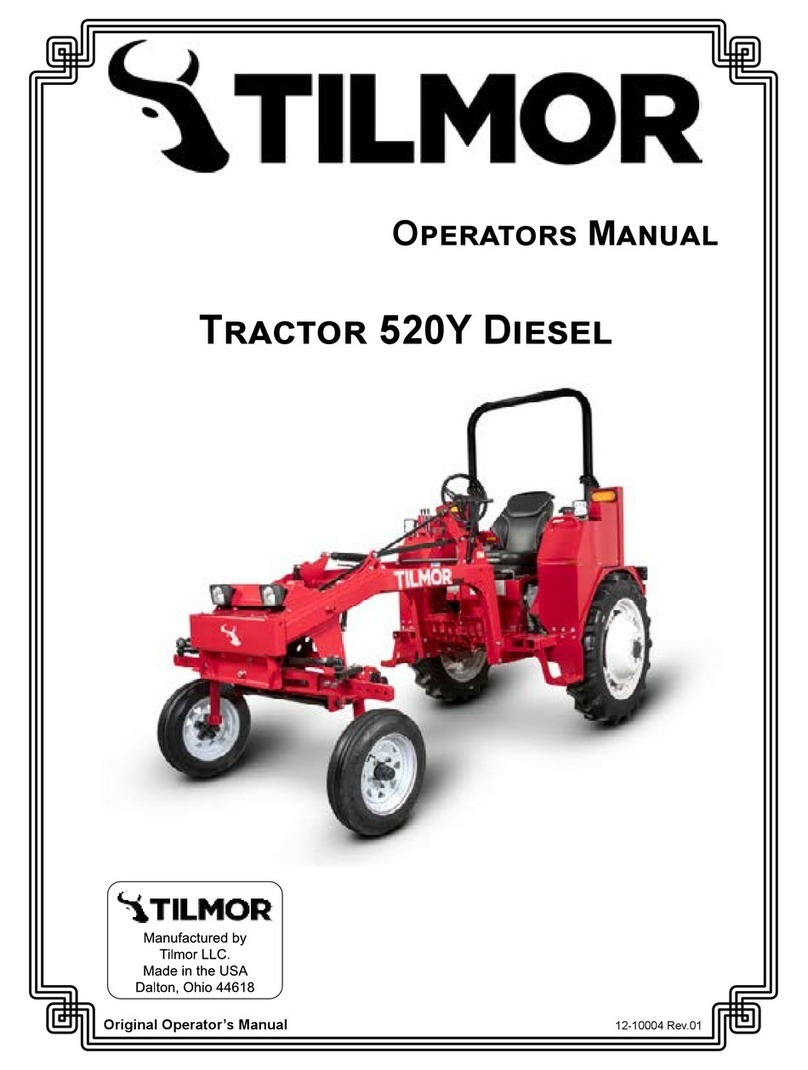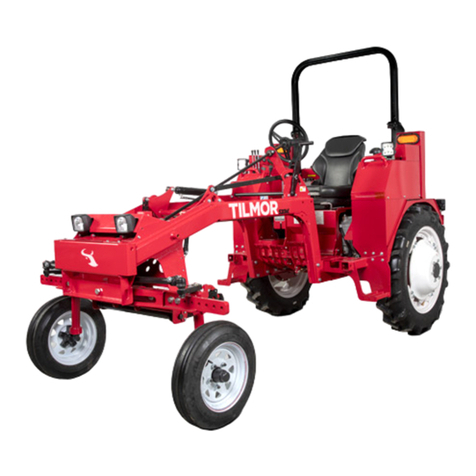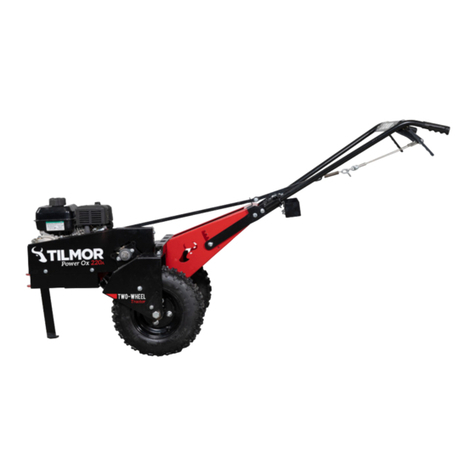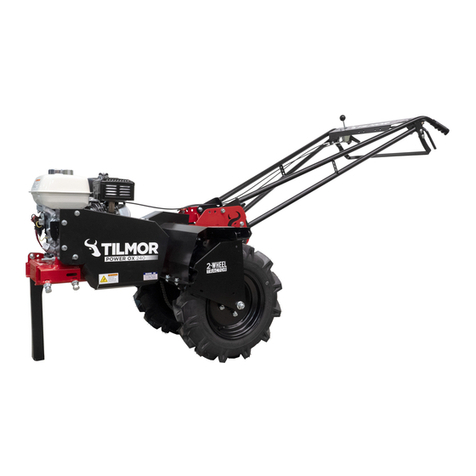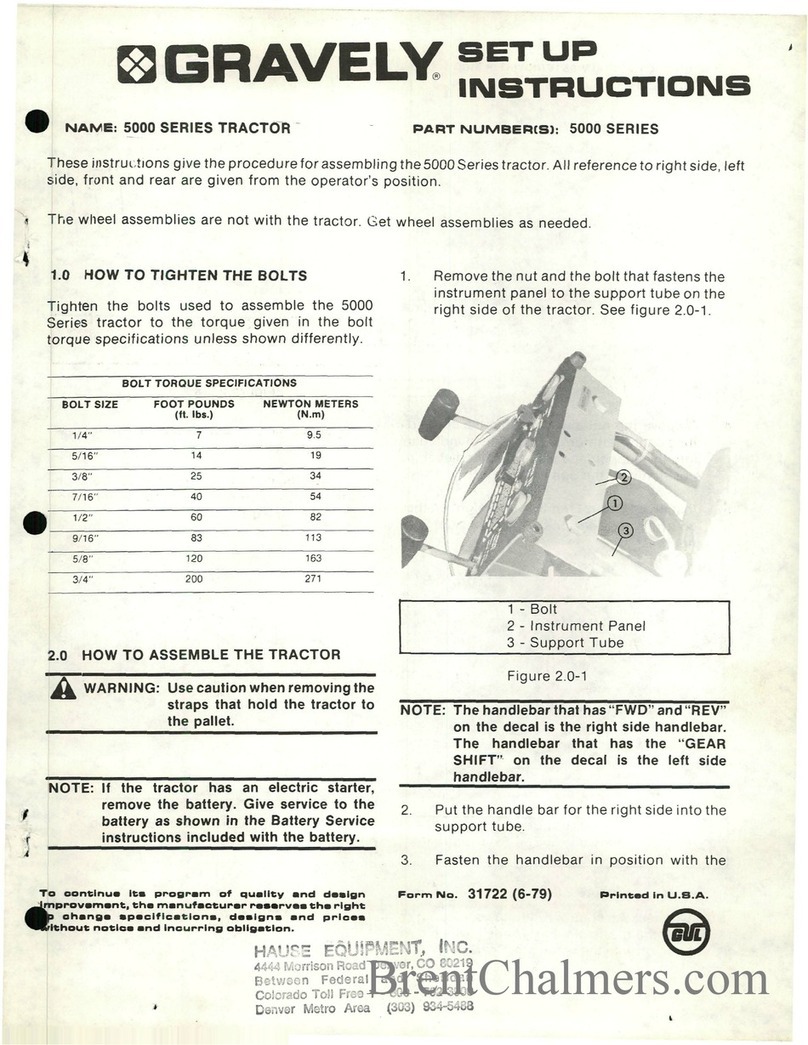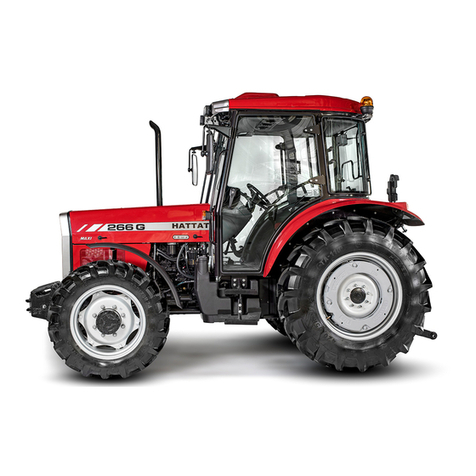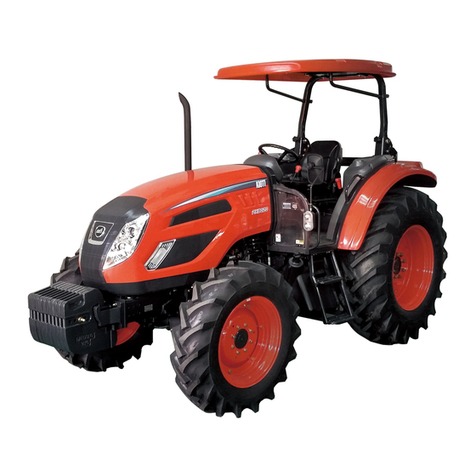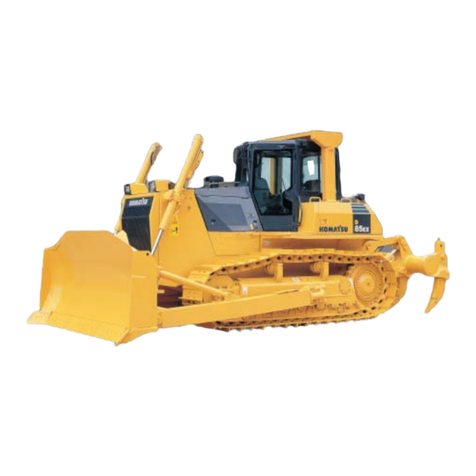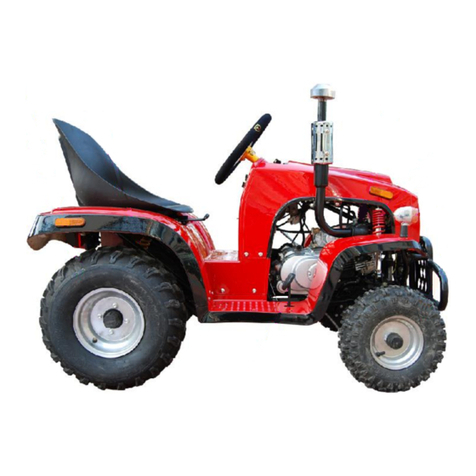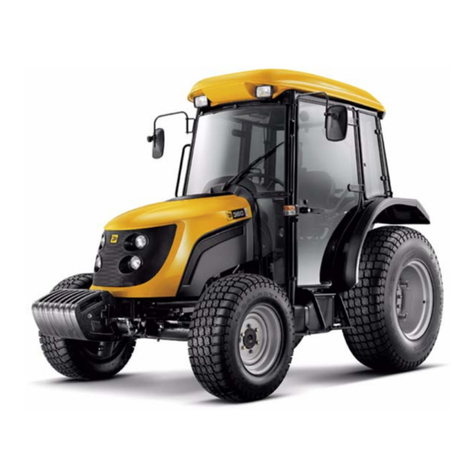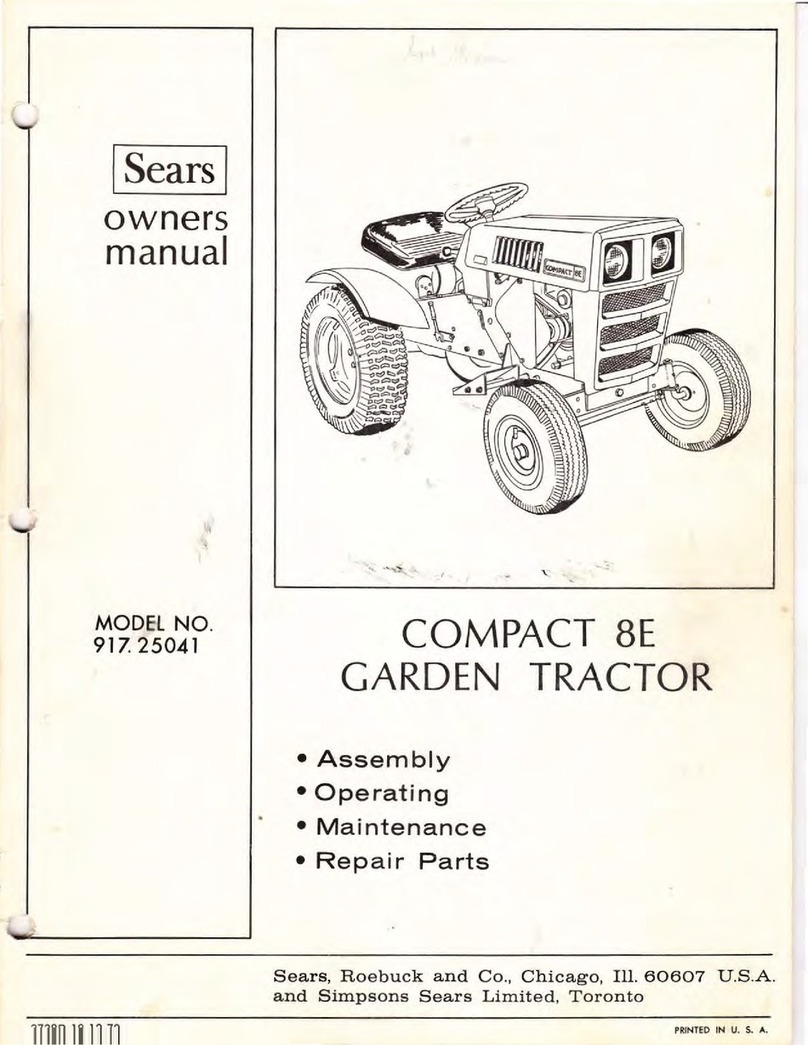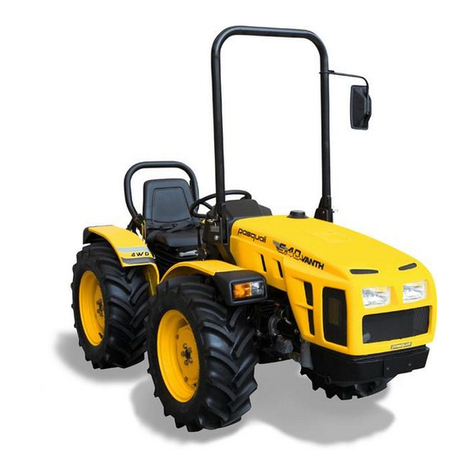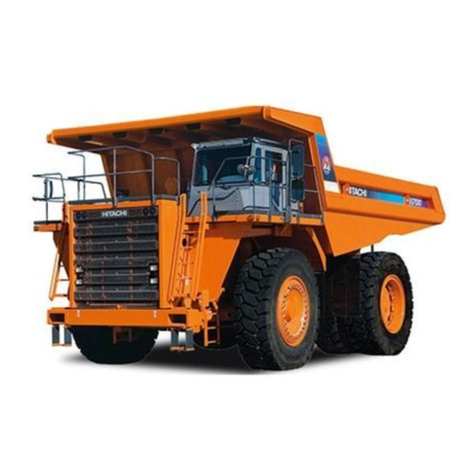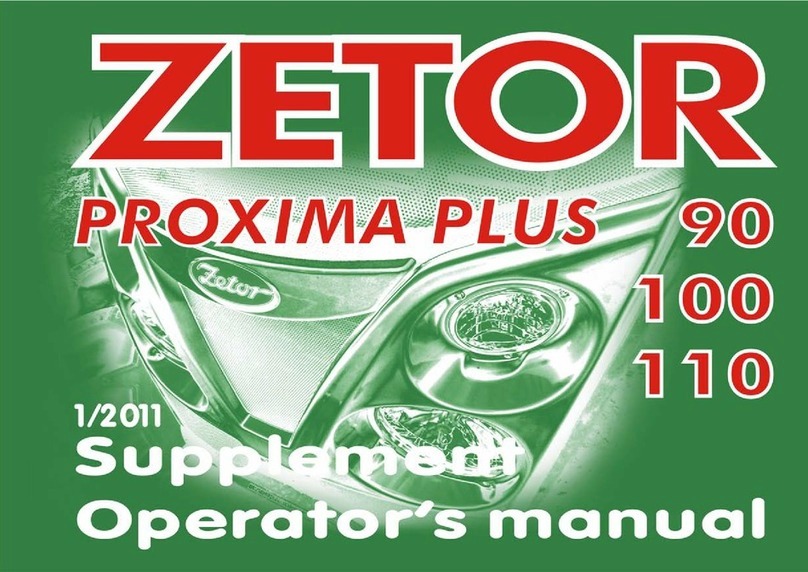TILMOR 520M User manual

12-10005 Rev.02

TABLE OF CONTENTS
Product Description................................................................................................................................6
Intended Use..........................................................................................................................................6
Replacement Parts.................................................................................................................................6
Using Your Manual.................................................................................................................................7
Manual Glossary ....................................................................................................................................7
Safety Decals.........................................................................................................................................8
Training Required................................................................................................................................. 11
Personal Protective Equipment Requirements .................................................................................... 11
Operation Safety .................................................................................................................................. 11
Preventing Accidents............................................................................................................................12
Keep Riders O....................................................................................................................................12
Mounting and Dismounting the Tractor ................................................................................................13
Use Caution On Slopes, Uneven Terrain, and Rough Ground.............................................................13
Roadway Safety...................................................................................................................................13
Truck or Trailer Transport.....................................................................................................................13
Towing Loads .......................................................................................................................................14
Maintenance Safety .............................................................................................................................14
Fuel Safety...........................................................................................................................................15
Roll Over Protective Structure (ROPS) ................................................................................................16
Operator Safety Interlock System ........................................................................................................17
Testing the Safety Interlock System .....................................................................................................17
Testing the Safety Interlock System (continued) ..................................................................................18
Standard Operational Control Locations..............................................................................................19
Optional Operational Control Locations ...............................................................................................20
Optional Operational Control Locations ...............................................................................................21
Speedometer Cluster Gauge (A)..........................................................................................................22
Tachometer Gauge Cluster (B) ............................................................................................................22
Ignition Switch (C) ................................................................................................................................23
Throttle Lever (D) .................................................................................................................................23
4 Speed Transmission Gear Shift Lever (F).........................................................................................23
Parking Brake (G) ................................................................................................................................23
Front Hydraulic Control Lever (H) ........................................................................................................23
Rear Hydraulic Control Lever (I) ..........................................................................................................23
Choke (J)..............................................................................................................................................24
Electrical System Circuit Breaker (K) ...................................................................................................24
Warning Alarm (L) ................................................................................................................................24
Depth Control Handle (M) ....................................................................................................................24
Steering Wheel (N)...............................................................................................................................24
Seat Latch Lever (P) ............................................................................................................................24
Fuel Shut-o Valve (Q).........................................................................................................................24
USB Port (R) ........................................................................................................................................24

TABLE OF CONTENTS
3
Hazard Flasher Switch (AA).................................................................................................................25
Head Light Switch (BB)........................................................................................................................25
Implement Light Switch (CC) ...............................................................................................................25
12 Volt Front Switch (DD) and 4 Pin Socket (OO) ...............................................................................25
Front Work Light Switch (EE)...............................................................................................................25
Rear Work Light Switch (FF)................................................................................................................25
Directional Signal Switch (HH) .............................................................................................................25
Horn Switch (II) ....................................................................................................................................26
Rear Auxiliary Quick Couplers (LL) ......................................................................................................26
12 Volt 7 Pin Socket (NN) ....................................................................................................................26
Front Auxiliary Quick Couplers (PP).....................................................................................................26
BPTO Control Handle (QQ) .................................................................................................................26
Lumbar Support Knob (SS)..................................................................................................................26
Seat Back Angle Adjustment Lever (TT) ..............................................................................................26
Weight Adjustment Lever (UU).............................................................................................................26
Height Adjustable Backrest (VV) ..........................................................................................................26
Implement Hoist Hook (WW)................................................................................................................26
Hoist Retaining Pin (XX) ......................................................................................................................27
Winch Handle (YY)...............................................................................................................................27
Winch Handle Storage (ZZ) .................................................................................................................27
Daily Inspection....................................................................................................................................28
Starting The Engine .............................................................................................................................28
Idling The Engine .................................................................................................................................28
Starting A Stalled Engine......................................................................................................................28
Shutting O The Engine.......................................................................................................................28
Driving The Tractor...............................................................................................................................29
Stopping The Tractor............................................................................................................................29
Emergency Stopping The Tractor ........................................................................................................29
Mid Mount Hitch ...................................................................................................................................29
Mid Mount Hitch Attaching ...................................................................................................................29
Depth Control Lever.............................................................................................................................29
Rear Hitch ...........................................................................................................................................29
Rear Hitch Attaching ............................................................................................................................29
Implement Hoist ...................................................................................................................................30
Belt Drive PTO (BPTO) ........................................................................................................................30
Tractor Track Width Adjustment ...........................................................................................................30
Ballast ..................................................................................................................................................32
Driving the Tractor on Roads ...............................................................................................................32
Towing ..................................................................................................................................................32
Service And General Maintenance.......................................................................................................33
Cleaning And Appearance Care...........................................................................................................33
Service Access Points..........................................................................................................................33

TABLE OF CONTENTS
4
Lubrication Locations ...........................................................................................................................35
Checking Hydraulic Fluid Level............................................................................................................36
Checking Engine Oil Level...................................................................................................................36
Changing Air Filter Elements................................................................................................................37
Filling The Fuel Tank ............................................................................................................................38
Checking the Brake Fluid.....................................................................................................................39
Checking the Transmission Fluid .........................................................................................................39
Checking Drive Belts............................................................................................................................40
Adjusting The Drive Belts Tension .......................................................................................................40
Adjusting Hydraulic Pump Belt Tension ...............................................................................................41
Cleaning Engine Compartment & Engine ............................................................................................42
Cleaning The Battery and Terminals ....................................................................................................42
Charging The Battery ...........................................................................................................................42
Jump Starting Procedure .....................................................................................................................43
Replacing Fuses ..................................................................................................................................43
Replacing Light Bulbs ..........................................................................................................................43
BPTO Belt Inspection...........................................................................................................................44
Clutch Pedal Adjustment ......................................................................................................................44
Steering Wheel Adjustment..................................................................................................................45
Tire Pressure........................................................................................................................................45
ROPS And Seat Belt Inspection...........................................................................................................45
Parking Brake Inspection & Adjustment ...............................................................................................46
Storage.................................................................................................................................................46
Preparing the Power Unit for Storage ..................................................................................................46
Long Term Storage (4 Months or Longer) ............................................................................................46
Short Term Storage (Less than 4 Months) ...........................................................................................46
Removing the Power Unit from Storage...............................................................................................46
Maintenance Schedule.........................................................................................................................47
Maintenance Checklist.........................................................................................................................48
Tilmor Maintenance Log.......................................................................................................................49
Tilmor Maintenance Log.......................................................................................................................50
Engine..................................................................................................................................................51
Engine (Continued) ..............................................................................................................................52
Hydraulic ..............................................................................................................................................52
Electrical ..............................................................................................................................................53
Wiring Diagram Reference Key............................................................................................................53
Wiring Circuit - Main Power / Ignition Switch Schematic......................................................................54
Wiring Circuit - Gauges / USB / AUX / Misc Fuse Block Schematic ....................................................55
Wiring Circuit - Operation Interlock Schematic ....................................................................................56
Wiring Circuit - Engine Functions / Diesel - Gas Schematic ................................................................57
Wiring Circuit - Head & Tail Light - Directional / Hazards Schematic ...................................................58
Engine..................................................................................................................................................59
Electrical...............................................................................................................................................59
Power Train ..........................................................................................................................................59

TABLE OF CONTENTS
Controls & Instrument Panel ................................................................................................................59
Other Features.....................................................................................................................................59
Dimensions ..........................................................................................................................................60
Load Capacities ...................................................................................................................................60
Fluid Capacities & Specications.........................................................................................................60
Return Policy & Procedure...................................................................................................................61
Warranty...............................................................................................................................................61
Non-serialized Product - 1 Year ...........................................................................................................61
Serialized Product - 2 Year or 1000 hours ...........................................................................................61
Tilmor Warranty Policy .........................................................................................................................61
Tilmor Warranty Procedure ..................................................................................................................61

INTRODUCTION
The Tilmor 520M tractor is the ultimate row crop tractor for diversied farming operations. The Tilmor 520M
is highly adaptable to meet the needs of a multitude of crops and cultural practices.
This tractor is designed solely for use in customary agricultural or similar operations. Use of the Tilmor 520
series tractor in any other manner is considered as contrary to the intended use.
This manual has been created to help you gain the important knowledge of what is needed to safely
operate, maintain, and service your machine. It is divided into sections for convenient reference of the
appropriate section.
You must read and understand the operator’s manual for each piece of Tilmor equipment you own. Read-
ing the operator’s manual will help you become familiar with each specic piece of equipment. Under-
standing the operator’s manual will help you, as well as others, avoid personal injury and/or damage to the
equipment. Keep this manual with the machine at all times. The manual should remain with the machine
even if it is sold. If this manual becomes damaged or unreadable, it should be replaced immediately. This
manual is available on our website at www.tilmor.com
When using a Tilmor attachment, be sure to read and follow the safety and operating instructions of both
the power unit and the attachment being used to ensure the safest operation possible.
The information in this manual provides the operator with the safest procedures to operate the machine
while getting the maximum use out of the unit. Failure to follow the safety precautions listed in this manual
may result in personal injury and/or damage to the equipment.
If any component of the 520 series tractor requires replacement, use only original Tilmor replacement parts.
Tilmor replacement parts are available on our website at www.tilmor.com or reach a customer service rep-
resentative at 1-844-255-5864.
Tilmor LLC. is pleased to provide you with your new Tilmor
tractor!
Please visit our website, www.tilmor.com for a complete list of
available Tilmor products, and resources.

INTRODUCTION
Throughout this manual, you will encounter special messages and symbols that identify potential safety
concerns to help you as well as others avoid personal injury or damage to the equipment.
This symbol identies potential health and
safety hazards. It marks safety precautions.
Your safety and the safety of others is involved.
There are three signal words that describe the level of safety concern: Danger, Warning, and Caution.
Safety should always be the #1 priority when working on or operating equipment. Accidents are more likely
to occur when proper operating procedures are not followed or inexperienced operators are involved.
Note: Right-Hand and Left-Hand orientations may be referred to at dierent places throughout this manual.
Right-Hand and Left-Hand is determined as if facing forward from the operator station.
DANGER
Indicates an imminently hazardous situation
which, if not avoided, will result in death or seri-
ous injury. This signal word is limited to the most
extreme cases.
WARNING
Indicates a potentially hazardous situation which,
if not avoided, could result in death or serious
injury.
CAUTION
Indicates a potentially hazardous situation which,
if not avoided, may result in minor or moderate
injury and/or property damage. It may also be
used to alert against unsafe practices.
A piece of Tilmor equipment that requires a Tilmor tractor for operation.
A device that attaches to a Tilmor tractor or Attachment to extend its capabilities.
Describes any “Implement” or “Accessory” that is used in conjunction with a Tilmor tractor.

The following safety decals must be maintained on your Tilmor 520M Tractor.
Keep all safety decals legible. Remove all grease, dirt, and debris from safety decals and instructional
labels. If any decals are faded, illegible, or missing, visit www.tilmor.com or call 1-844-255-5864 for replace-
ments. When replacement or new components are installed, be sure that current safety decals are axed
to the replacement or new part.
AA
BB
CC
BBBB
BB
BB
BB
DD
EE

SAFETY
AA1 3 4
2
5678910
1. Read the manual before operating the tractor.
2. Wear personal protective equipment, such as safety
glasses, closed toe shoes or boots, and ear protection.
3. Operators must receive training prior to operating the
machine.
4. Do not operate with shields or guards removed.
5. Slow down and use caution when turning the tractor.
Operators must ensure that the ROPS is in the raised
and locked position during operation.
6. WARNING: Keep a safe distance from the edge of drop
-os, ditches, and embankments. The machine could
roll over if a wheel drops over the edge or if the edge
caves in.
7. Do not carry passengers. Stop the machine if someone
enters the area.
8. Set the parking brake and lower implements and shut
o the engine before dismounting the tractor.
9. Do not operate while under the inuence of drugs or
alcohol.
10. WARNING: Hydraulic uid is under high pressure and
can penetrate skin, causing injury. Keep hands, face,
and body away from pinholes or nozzles that eject
hydraulic uid under high pressure.
1. Wear eye protection, such as gog-
gles or a face shield, when checking
or servicing batteries.
2. Wear appropriate protective gear,
such as rubber gloves and an
apron, when checking or servicing
batteries.
3. Danger: Battery acid is caustic and
can cause chemical burns. Keep
bystanders a safe distance from the
battery.
4. Do not expose batteries to arcs,
sparks, or open ames. Do not use
smoking materials near batteries.
5. Explosion hazard - batteries pro-
duce ammable and explosive
gases.
1
2
3 4
5
CC
1. Cutting/crushing hazard - Stay away
from moving parts.
1. Hot surface hazard - Hot surfaces
can cause severe burns. Allow
engine, exhaust components, and
surrounding surfaces to cool before
servicing.
DD
1
BB
1

SAFETY
A Operator Safety 00-0548 1
B Warning - Pinch Point 00-0218 6
C Warning - Battery 00-0366 1
D Warning - Hot Surface 00-0374 1
E Danger - Unleaded Gasoline Only 00-0550 1
FROPS Certication 00-0611 1
FF
1. DANGER: Explosion/Fire Hazard
2. Keep away from re, sparks, and pilot
lights when refueling or storing tractor
and fuel.
3. Smoking is prohibited.
1 2 3
EE

SAFETY
• The owner of this machine is solely responsible for properly training the
operators.
• The owner/operator is solely responsible for the operation of this machine
and prevention of accidents or injuries occurring to him/herself, other people
or property.
• Do not allow operation or service by children or untrained personnel. Local
regulations may restrict the age of the operator.
• Before operating this machine, read the operator’s manual and understand
its contents.
• If the operator of the machine cannot understand this manual, then it is the responsibility of this machines
owner to fully explain the material within this manual to the operator.
• Learn and understand the use of all controls.
• Know how to stop the power unit and all attachments quickly in the event of an emergency.
It is the responsibility of the owner to be sure that the operators use the proper personal protective equipment
while operating the machine. Required personal protective equipment includes, but is not limited to, the follow-
ing list.
• Wear a certied ear protection device to prevent loss of hearing.
• Wear close tting clothing and safety equipment appropriate for the job.
• Closed toe shoes must be worn at all times.
• When operating in dusty conditions, it is recommended that a dust mask must be worn.
• Inspect machine before operation. Repair or replace any damaged, worn or missing parts. Be sure guards
and shields are in proper working condition and are secured in place. Make all necessary adjustments
before operating the machine.
• Some pictures in this manual may show shields or covers opened or removed in order to clearly illustrate
any instructions. Under no circumstance should the machine be operated without these devices in place.
• Alterations or modications to this machine can reduce safety and could cause damage to the machine. Do
not alter safety devices or operate with shields or covers removed.
• Before each use, verify that all controls function properly and inspect all safety devices. Do not operate if
the controls or safety devices are not in proper working condition.
• Check parking brake function before operating. Repair or adjust the parking brake if necessary.
• Observe and follow all safety decals.
• All controls are to be operated from the operators station only.
• Always wear a seat belt if the machine has a roll cage/bar installed and in the upright position.
• Ensure the attachment or accessory is locked or fastened securely to the power unit before operating.
• Ensure that all bystanders are clear of the power unit and attachment before operating. Stop the machine if
someone enters your work area.
• Always be alert to what is happening around you, but do not lose focus on the task you are performing.
Always look in the direction the machine is moving.
• Look behind and down before backing up to be sure of a clear path.
• If you hit an object, stop and inspect the machine. Make all necessary repairs before operating the
machine again.

SAFETY
• Stop operation immediately at any sign of equipment failure. An unusual noise can be a warning of equip-
ment failure or a sign that maintenance is required. Make all necessary repairs before operating the
machine again.
• If equipped with a high/low range feature, never shift between high and low range while on a slope. Always
move the machine to level ground and engage the parking brake before shifting range.
• Do not leave the machine unattended while it is running.
• Always park the machine on level ground.
• Always shuto the engine when connecting a implement or accessory to the power unit.
• Never leave the operator’s station without lowering the attachment to the ground, setting the parking brake,
shutting o the engine, and removing the ignition key.
• Only operate in well lit conditions.
• Do not operate when there is a risk of lightning.
• Never direct the discharge of any implement or accessory in the direction of people, buildings, animals,
vehicles, or other objects if value.
• Never discharge material against a wall or obstruction. Material may ricochet back towards the operator.
• Use extra caution when approaching blind corners, shrubs, trees, or other objects that may obscure vision.
• Do not run the engine in a building without adequate ventilation.
• Do not touch the engine or the muer while the engine is running or immediately after stopping the engine.
These areas may be hot enough to cause a burn.
• Do not change the engine governor settings or over-speed the engine. Operating the engine at excessive
speed may increase the hazard or personal injury.
• To reduce the hazard of re, keep the battery compartment, engine, and muer areas free of grass,
leaves, excessive grease, and other ammable materials.
• Clear working area of objects that might be hit or thrown from machine.
• Keep people and pets out of the working area.
• Know the work area well before operation. Do not operate where traction or
stability is questionable.
• Reduce speed when you are operating over rough ground.
• Equipment can cause serious injury and/or death when improperly used. Before
operating, know and understand the
operation and safety of the power unit
and the attachment being used.
• Do not operate the machine if you are not in good physical and
mental health, if you will be distracted by personal devices, or are
under the inuence of any substance which might impair decision,
dexterity, or judgement.
• Children are attracted to machine activity. Be aware of children and
do not allow them in the working area. Turn o the machine if a child enters the work area.
• Only allow the operator on the power unit. Keep riders o.
• Never allow riders on any attachment or accessory.

SAFETY
• To prevent falling accidents always face the machine when mounting or dismounting. Maintain three
points of contact with steps and hand holds.
• Never mount or dismount a moving machine.
• Use extra caution when slippery conditions may be present.
• Keep the steps clean and free of grease or oil.
• Never jump when dismounting the tractor.
• Slopes, uneven terrain, and rough ground
can cause loss-of-control and tip-over
accidents, which can result in severe
injury or death. Operating the tractor on
slopes, uneven terrain, and rough ground
requires extra caution.
• Avoid sharp up hill turns while on a slope.
• Choose a slow ground speed so you will
not have to shift gears or stop on a slope.
• Make sure to move slowly and gradual on
a slope, do not make any sudden changes in direction or speed.
• Avoid obstructions, ditches, and holes which may cause the tractor to become unstable or tip.
• Stay away from drop-os, ditches, embankments, and bodies of water.
• Pulling loads on slopes decreases safety. It is the responsibility of the owner/operator to determine loads
that can safely be controlled on slopes.
• Not all conditions in which a tractor could overturn are listed. Be aware of situations or conditions that could
cause the tractor to become unstable.
• Operate with safety lights when operating on or near roadways.
• Obey all state and local laws concerning operation on roadways.
• Slow down and be careful of trac when operating near or crossing roadways. Stop
before crossing roads or sidewalks. Use care when approaching areas or objects that may
obscure vision.
• If there is doubt of safety conditions, discontinue machine operation until a time when operation can be
performed safely.
• When operating near or on roadways, have a Slow Moving Vehicle Emblem clearly displayed.
• Use care when loading or unloading machine on or into a truck or trailer.
• Use full width ramps for loading the machine on or into a truck or trailer.
• The parking brake is not sucient to lock the machine during transport. Always secure the power unit and/
or implement to the transporting vehicle securely using straps, chains, cable, or ropes. Both front and rear
straps should be directed down and outward from the machine.
• Shut o the fuel supply to the power unit during transport on truck or trailer.
• If equipped, turn the battery disconnect switch to the OFF position and shut o electrical power.

SAFETY
General Safety Procedures
for Ventrac Power Units, Attachments, & Accessories
• Use caution when towing and stopping heavy loads. Stopping distance increases with speed and weight of
towed loads.
• Towed loads with or without brakes that are too heavy for the tractor or are towed too fast can cause loss of
control.
• Consider the total weight of equipment being towed.
• Before transporting a towed implement, reference the implement operators manual or look for decals on the
implement the provide information on the implements transport speed.
• Never transport an implement at a speed that exceeds the implement’s maximum transport speed.
• Ensure that a safety chain(s) are used when towing equipment. A safety chain will aid in controlling towed
equipment if the equipment separates from the draw bar or hitch. The safety chain should only have enough
slack in the chain to allow for turning.
• Keep all safety decals legible. Remove all grease dirt, and debris from safety decals and instructional labels.
• If any decals are faded, illegible, or missing, replacements can be obtained at www.tilmor.com.
• When new components are installed, be sure that current safety decals are axed to the replacement com-
ponents.
• If any component requires replacement, use only original Tilmor replacement parts.
• Always turn the battery disconnect to the OFF position or disconnect the battery before performing any
repairs. Disconnect the negative terminal rst and the positive terminal last. Reconnect the positive terminal
rst and the negative terminal last.
• Keep all bolts, nuts, screws, and other fasteners properly tightened.
• Always lower the attachment to the ground, engage parking brake, shut o engine, and remove the igni-
tion key. Make sure all moving parts have come to a complete stop before cleaning, inspection, adjusting or
repairing.
• Never perform maintenance on the power unit and/or attachment if someone is in the operator’s station.
• Always use protective glasses when handling the battery.
• Check all fuel lines for tightness and wear on a regular basis. Tighten or repair them as needed.
• To reduce the hazard of re, keep the battery compartment, engine, and muer areas free of grass, leaves,
and grease.
• Do not touch the engine, the muer, or other exhaust components while the engine is running or immediately
after stopping the engine. These areas may be hot enough to cause a burn.
• Allow the engine to cool before storing and do not store near an open ame.
• Do not change the engine governor settings or over-speed the engine. Operating engine at excessive speed
may increase the hazard of personal injury.
• Springs may contain stored energy. Use caution when disengaging or removing springs and/or spring loaded
components.
• An obstruction or blockage in a drive system or moving/rotating parts may cause a buildup of stored energy.
When the obstruction or blockage is removed, the drive system or moving/rotating parts may move suddenly.
Do not attempt to remove an obstruction or blockage with your hands. Keep hands, feet and clothing away
from all power-driven parts.
• Dispose of all uids in accordance with local laws.

SAFETY
• To avoid personal injury or property damage, use extreme care in handling gasoline.
Gasoline is extremely ammable and the vapors are explosive.
• Do not refuel the machine while smoking or at a location near ames or sparks.
• Always refuel the machine outdoors.
• Do not store machine or fuel container indoors where fumes or fuel can reach an open ame,
spark, or pilot light.
• Only store fuel in an approved container. Keep out of reach of children.
• Never ll containers inside a vehicle or on a truck or trailer bed with a plastic liner. Always place containers
on the ground away from your vehicle before lling.
• Remove the machine from the truck or trailer and refuel it on the ground. If this is not possible, refuel the
machine using a portable container, rather than from a fuel dispenser nozzle.
• Never remove the fuel cap or add fuel with the engine running. Allow the engine to cool before refueling.
• Replace all fuel tank and container caps securely.
• Do not overll fuel tank. Only ll the bottom of the fuel neck, do not ll the fuel neck full. Overlling of the
fuel tank could result in engine ooding, fuel leakage from the tank, and/or damage to the emissions con-
trol system.
• If fuel is spilled, do not attempt to start the engine. Move the power unit away from the fuel spill and avoid
creating any source of ignition until vapors have dissipated.
• If the fuel tank must be drained, it should be drained outdoors into an approved container.
• Dispose of all uids in accordance with local laws.
• Check all fuel lines for tightness and wear on a regular basis. Tighten or repair them as needed.
• The fuel system is equipped with a shut-o valve. Shut o the fuel when transporting the machine to and
from the job, when parking the machine indoors, or when servicing the fuel system.
• Make sure all hydraulic connections are tight and all hydraulic hoses and tubes are in good condition.
Repair any leaks and replace any damaged or deteriorated hoses or tubes before starting the machine.
• Hydraulic leaks can occur under high pressure. Hydraulic leaks require special care and attention.
• Use a piece of cardboard and a magnifying glass to locate suspected hydraulic leaks.
• Keep body and hands away from pinhole leaks or nozzles that eject
high pressure hydraulic uid. Hydraulic uid escaping under high
pressure can penetrate the skin causing serious injury, leading to
severe complications and/or secondary infections if left untreated.
If hydraulic uid is injected into the skin, seek immediate medical
attention no matter how minor the injury appears.
• The hydraulic system may contain stored energy. Before performing
maintenance or repairs on the hydraulic system, remove attach-
ments, engage the parking brake, disengage weight transfer system
(if equipped), shut o the engine, and remove the ignition key.
• Dispose of all uids in accordance with local laws.
•

SAFETY
WARNING
Keep the ROPS locked in the upright position and
the seat belt securely fastened during operation.
Failure to do so could result in serious injury or loss
of life.
WARNING
Alterations or modications to this machine and/
or the ROPS structure can reduce safety and could
cause damage to the machine. Do not alter the
ROPS. Do not alter any other safety devices.
Your power unit is equipped with a Roll-Over Protective Structure (ROPS). This ROPS was tested and certi-
ed in accordance with the following standards.
ISO 5700:2013
ISO 3776-2
• ROPS certication applies only when the roll bar is locked in the upright position. Be aware there is no
rollover protection when a folding ROPS is in the down position.
• DO NOT remove the ROPS. Alterations to the ROPS structure are not permitted.
• Lower the roll bar only when absolutely necessary and raise the roll bar to the upright position as soon as
clearance allows. Never lower a folding ROPS in areas where there are slopes, drop os, or water.
• Check carefully for overhead clearances (i.e. branches, doorways, electrical wires) before driving under
any objects and do not contact them.
• Always wear the seat belt when the roll bar is locked in the upright position. Be certain the seat belt can be
released quickly in the event of an emergency.
• Do not wear a seat belt when the roll bar has been lowered to the down position.
• If any part of this ROPS experiences structural damage, the entire ROPS must be replaced.
• Inspect the seat belt for wear or damage before use. Failure to inspect or maintain the seat belt can cause
injury or loss of life.

SAFETY
The Tilmor 520M Tractor is equipped with a safety interlock system. This system:
• Prevents the engine from starting unless the operator is present in the seat.
• Prevents the engine from starting unless the transmission is in neutral.
• Shuts o the engine if the BPTO is engaged and the operator leaves the seat.
WARNING
Never operate the power unit if the safety interlock
system is malfunctioning. Do not disengage or
bypass any switch. Failure to observe this warning
could result in injury to yourself and others, or
damage to property and equipment.
WARNING
Ensure that the parking brake is set during the
testing of the safety interlock system. Failure
to observe this warning could result in injury to
yourself and others, or damage to property and
equipment.
CAUTION
The daily inspection should be performed prior to
the initial startup for the day.
Perform the following safety interlock tests daily to test the electrical portion of the interlock system.
Before testing, park the tractor on a level surface, set the parking brake, and place the high/low range
shift lever in the neutral position. After testing is complete place the high/low shift lever in either high or
low range, and set the parking brake.

SAFETY
test the ‘Engine Start’ function. For each test, ensure that the parking brake is engaged and
the high/low range shift lever is in the neutral position. As listed below for each test put the transmission
in gear or neutral position, ensure there is or is not an operator present in the seat, and engage or disen-
gage the BPTO if equipped.
ENGINE
START
Test
Number
Transmission
in Neutral
Operator
Present in Seat
BPTO
Engaged
if Equipped
Engine Starts
1 No Yes No No
2Yes No No No
3Yes Yes Yes No
4Yes Yes No Yes
test the ‘Engine Run’ function. For each test, ensure that the parking brake is engaged, the
transmission is in the neutral position, and the high/low range shift lever is in the neutral position. For
each test ensure that the engine is running. As listed for each test sit on the seat or raise body weight
from the seat, and engage or disengage the BPTO. The engine should continue or stop running as
described for each test.
ENGINE
RUN
Test
Number
Operator
Present in Seat
BPTO
Engaged
if Equipped
Engine Runs
5Yes Yes Yes
6 No Yes No
7Yes No Yes
8 No No Yes

OPERATIONAL CONTROLS
Use the following images to help identify the loca-
tions of operational controls. The letter next to each
control can be referenced to the list that follows
these images.
M
N
K
L
A
G
B
C
F
D
E
H
I
J
O
P
Q
R
T
S
U

OPERATIONAL CONTROLS
Use the following images to help identify the loca-
tions of operational controls. The letter next to each
control can be referenced to the list that follows
these images.
AA
BB CC DD
EE FF GG
HH
II
JJ KK
MM
Rear Hitch ArmsRear Hitch Arms
LL
NN
Front Hitch ArmsFront Hitch Arms
OO
PP
QQ
Table of contents
Other TILMOR Tractor manuals
